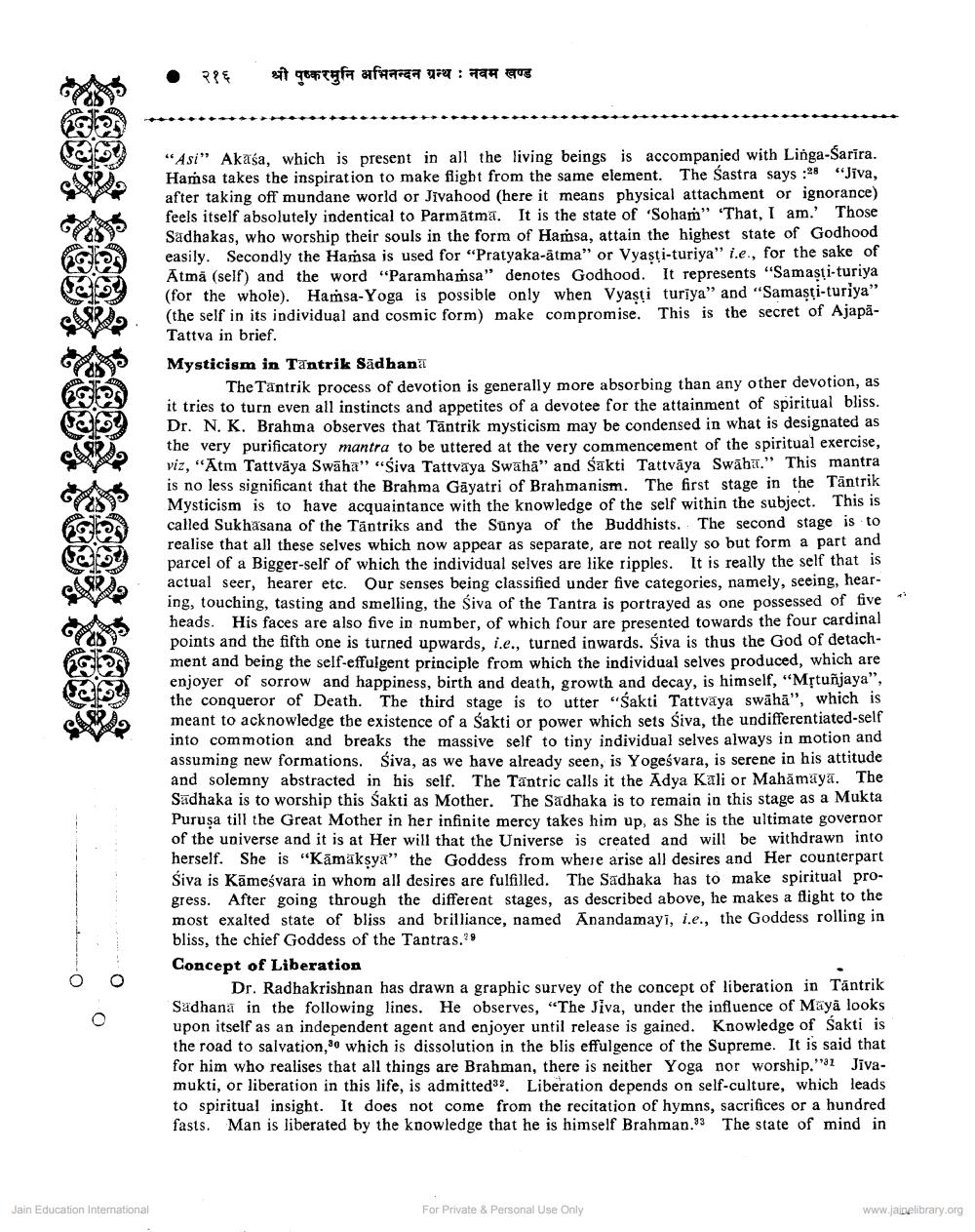Book Title: Philosophy of Tantrik Yoga Sadhna Author(s): Vaishishtha Narain Tripathi Publisher: Z_Pushkarmuni_Abhinandan_Granth_012012.pdf View full book textPage 7
________________ • २१६ श्री पुष्करमुनि अभिनन्दन ग्रन्थ : नवम खण्ड TLT "Asi" Akaśa, which is present in all the living beings is accompanied with Linga-Sarira. Hamsa takes the inspiration to make flight from the same element. The Sastra says :28 "Jiva, after taking off mundane world or Jivahood (here it means physical attachment or ignorance) feels itself absolutely indentical to Parmātmā. It is the state of 'Soham" "That, I am.' Those Sadhakas, who worship their souls in the form of Hamsa, attain the highest state of Godhood easily. Secondly the Hamsa is used for "Pratyaka-åtma" or Vyasti-turiya" i.e., for the sake of Atma (self) and the word "Paramhamsa" denotes Godhood. It represents "Samasti-turiya (for the whole). Haṁsa-Yoga is possible only when Vyasti turiya" and "Samasti-turiya" (the self in its individual and cosmic form) make compromise. This is the secret of AjapāTattva in brief. Mysticism in Tantrik Sadhana The Tantrik process of devotion is generally more absorbing than any other devotion, as it tries to turn even all instincts and appetites of a devotee for the attainment of spiritual bliss. Dr. N. K. Brahma observes that Tantrik mysticism may be condensed in what is designated as the very purificatory mantra to be uttered at the very commencement of the spiritual exercise, viz, "Atm Tattvāya Swāha" "Śiva Tattvaya Swāhā" and sakti Tattvāya Swāhu." This mantra is no less significant that the Brahma Gāyatri of Brahmanism. The first stage in the Tantrik Mysticism is to have acquaintance with the knowledge of the self within the subject. This is called Sukhasana of the Tantriks and the Sünya of the Buddhists. The second stage is to realise that all these selves which now appear as separate, are not really so but form a part and parcel of a Bigger-self of which the individual selves are like ripples. It is really the self that is actual seer, hearer etc. Our senses being classified under five categories, namely, seeing, hearing, touching, tasting and smelling, the siva of the Tantra is portrayed as one possessed of five" heads. His faces are also five in number, of which four are presented towards the four cardinal points and the fifth one is turned upwards, i.e., turned inwards. Siva is thus the God of detachment and being the self-effulgent principle from which the individual selves produced, which are enjoyer of sorrow and happiness, birth and death, growth and decay, is himself, "Mstuñjaya", the conqueror of Death. The third stage is to utter "Śakti Tattvaya swāhā", which is meant to acknowledge the existence of a Sakti or power which sets Śiva, the undifferentiated-self into commotion and breaks the massive self to tiny individual selves always in motion and assuming new formations. Siva, as we have already seen, is Yogeśvara, is serene in his attitude and solemny abstracted in his self. The Tantric calls it the Adya Kali or Mahamaya. The Sadhaka is to worship this Śakti as Mother. The Sadhaka is to remain in this stage as a Mukta Puruşa till the Great Mother in her infinite mercy takes him up, as She is the ultimate governor of the universe and it is at Her will that the Universe is created and will be withdrawn into herself. She is "Kāmaksya" the Goddess from where arise all desires and Her counterpart Siva is Kāmeśvara in whom all desires are fulfilled. The Sadhaka has to make spiritual progress. After going through the different stages, as described above, he makes a flight to the most exalted state of bliss and brilliance, named Anandamayi, i.e., the Goddess rolling in bliss, the chief Goddess of the Tantras.29 Concept of Liberation Dr. Radhakrishnan has drawn a graphic survey of the concept of liberation in Tantrik Sadhana in the following lines. He observes, “The Jiva, under the influence of Maya looks upon itself as an independent agent and enjoyer until release is gained. Knowledge of Sakti is the road to salvation, which is dissolution in the blis effulgence of the Supreme. It is said that for him who realises that all things are Brahman, there is neither Yoga nor worship." Jivamukti, or liberation in this life, is admitted. Liberation depends on self-culture, which leads to spiritual insight. It does not come from the recitation of hymns, sacrifices or a hundred fasts. Man is liberated by the knowledge that he is himself Brahman. The state of mind in Jain Education International For Private & Personal Use Only www.jainelibrary.orgPage Navigation
1 ... 5 6 7 8 9
